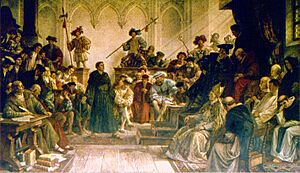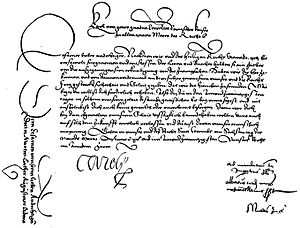Imperial Diet (Holy Roman Empire) facts for kids
Quick facts for kids Imperial DietDieta Imperii (Latin) Reichstag (German) |
|
|---|---|
| Deliberative body of the Holy Roman Empire | |
 |
|
| History | |
| Founded | 803 |
| Disbanded | 1806 |
| Succeeded by | Diet of the Confederation (Confederation of the Rhine) |

The Imperial Diet (also known as Reichstag in German) was like a big meeting or assembly for the Holy Roman Empire. It wasn't a modern parliament that made laws. Instead, it was a place where important people from the Empire came together to talk, negotiate, and try to agree on things.
Its members were called the Imperial Estates. They were divided into three main groups. This assembly became a regular meeting place over time. From 1663 until the Empire ended in 1806, it met permanently in a city called Regensburg.
All members of the Imperial Diet were "immediate." This meant they answered only to the Holy Roman Emperor himself, not to any other ruler. Important princes had their own individual vote. Smaller groups, like counts or abbots, shared a collective vote. Free imperial cities also had a collective vote.
The right to vote was usually tied to owning land. So, if a prince gained new lands, they also gained the voting rights that came with those lands. Most members didn't go to the permanent meetings in Regensburg themselves. Instead, they sent representatives to speak for them.
Contents
How the Imperial Diet Changed Over Time
The Imperial Diet's role changed a lot over hundreds of years. The different parts of the Empire, like dukes and princes, slowly gained more power. The Emperor's power became less important. At first, there was no set time or place for these meetings. They started as gatherings of dukes from the old Germanic tribes. These meetings happened when big decisions needed to be made.
In the early Middle Ages, these meetings were not yet formal. They were called Hoftage (court assemblies). They usually took place in the Emperor's palaces. For example, Emperor Charlemagne held a Hoftag in Paderborn in 777. There, laws were made for the Saxons and other tribes.
Important Meetings and Changes
At a meeting in Fritzlar in 919, the dukes elected the first King of the Germans. This was Henry the Fowler, a Saxon. This event helped create the German realm. Later, in 1158, the Diet of Roncaglia made four laws. These laws weakened the central power of the Emperor. They gave more power to the local dukes.
The Golden Bull of 1356 was a very important document. It made it clear that dukes had a lot of independent power over their lands. It also set the number of electors (princes who chose the Emperor) to seven. The Pope was not involved in choosing the Emperor.

19th-century painting by Hermann Wislicenus
The Diet became a formal institution around the late 1400s. Before that, it was just irregular meetings. From 1489, it was officially called the Reichstag. It was then divided into different "colleges" or groups.
At first, there were two colleges: the electors and the other princes. Later, the imperial cities joined as a third group. These cities were independent republics. They answered only to the Emperor.
Many attempts were made to reform the Empire. These efforts tried to stop its slow breakup. But they didn't work very well. The Peace of Westphalia in 1648 made things worse for the Emperor. This treaty forced the Emperor to accept all decisions made by the Diet. This took away most of his remaining power. After 1648, the Empire was mostly a collection of independent states.
Some of the most famous Diets happened in Worms in 1495. Here, big reforms were made. Another famous one was in Worms in 1521. This is where Martin Luther was banned for his religious ideas. The Diets of Speyer in 1526 and 1529 were also very important. They dealt with the growing Protestant movement. From 1663, the Diet met permanently in Regensburg. This was known as the Perpetual Diet of Regensburg.
Who Was Part of the Diet?
From 1489, the Imperial Diet had three main groups, or colleges:
The Electors
The Electoral College was led by the Prince-Archbishop of Mainz. These seven prince-electors were chosen by the Golden Bull of 1356. They were the most powerful princes. They had the right to elect the Holy Roman Emperor.
There were:
- Three church leaders (Prince-Archbishops):
* Mainz * Cologne * Trier
- Four secular (non-church) princes:
* The King of Bohemia * The Elector of the Palatinate * The Elector of Saxony * The Margrave of Brandenburg
Over time, the number of electors changed. For example, the Duke of Bavaria became an elector in 1623. Later, the Elector of Hanover became the ninth elector in 1692. These changes often happened because of wars or new agreements. However, these changes didn't last long. The Holy Roman Empire was dissolved in 1806.
The Princes
The college of Imperial Princes included many different rulers. These were counts, lords, bishops, and abbots. They had a lot of members. But they often disagreed with each other. They tried to protect their interests against the powerful electors.
This group was divided into two benches: church leaders and secular (non-church) rulers. Each member either had a single vote or a collective vote. This meant that some smaller rulers had to group together to cast one vote.
The Cities
The college of Imperial Cities started to form from 1489. These cities were very important in making the Imperial Diet a political body. Their collective vote became more important over time. The city where the Diet met usually led this college. When the Diet moved permanently to Regensburg in 1663, Regensburg took over the leadership.
The Imperial cities were also divided into two groups: Swabian and Rhenish. Important Swabian cities included Nuremberg, Augsburg, and Regensburg. Key Rhenish cities were Cologne, Aachen, and Frankfurt.
Religious Matters in the Diet
After the Peace of Westphalia in 1648, religious issues could not be decided by a simple majority vote. Instead, the Diet would split into two separate groups: Catholic and Protestant. This process was called the itio in partes. Each group would discuss the matter on its own. Then, they would negotiate with each other to reach an agreement.
The Catholic group was led by the Archbishop-Elector of Mainz. The Protestant group was led by the Elector of Saxony. Even when the Elector of Saxony converted to Catholicism, the Electorate itself remained Protestant. So, Saxony continued to lead the Protestant group until the Empire ended.
See also
- Imperial Diet (disambiguation)



